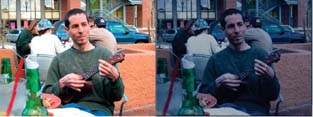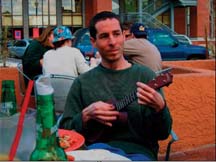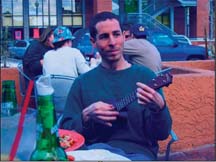Hack 68. Change a Scene from Day to Night
| < Day Day Up > |
|
Using color-correction tools, you can make a scene that was shot during the day look like it was shot at night. Not everyone has the experience or luxury to shoot a scene at night. If you find you need a nighttime scene but cannot shoot at night, there are a few color-correction tricks you can use to fake a nighttime look.
6.9.1. Using the Color CorrectorThe primary difference between a daytime shot and a nighttime shot is the way colors are perceived. You will notice that at night everything takes on a blue-purple hue. This is the effect you are going to mimic.
While using your editing application, locate the scene you would like to alter and select it. Then, open the color correction tool:
There are a few key terms to be familiar with when color correcting:
In order to create the day-for-night effect, you will need to manipulate the Chroma, Gamma, and Luminance, in addition to altering the blacks, whites, and midtones. Depending on the features of your editing system or the plug-in you have chosen to use, your results will vary. Additionally, every shot is different, due to lighting, the camera lens used, and color composition of the scene, so you will need to adjust accordingly. Figure 6-24 shows the original image next to a day-for-night-effected image. Figure 6-24. Mele Kalikimaka, during the day and at night 6.9.2. Reducing the Luminance and ChrominanceOne of the first steps in creating the day-for-night effect is to reduce the luminance and chrominance of your scene. Obviously, by reducing the luminance, you will lose some of your scene's clarity. But, then again, when you are walking around at night, you can't see as clearly as during the day. Right? You will also want to reduce the chrominance. This will cause some of the subjects of your scene to not stand out as much. As with all of the changes you are applying, you will need to experiment to see how much chrominance you need to remove. Figure 6-25 shows the image with the luminance and chrominance adjusted. Figure 6-25. An image with altered luminance and chrominance 6.9.3. Reducing the GammaIf you have the ability to reduce the gamma of your scene, you should do so. However, keep in mind that a little can go a long way when dealing with gamma settings. Figure 6-26 shows the image with a slightly adjusted gamma level, from 1.0 to 0.95. Figure 6-26. Slightly adjusting the gamma level 6.9.4. Pushing the BlacksIn order to add a blue-purple hue to your scene, you can push your blacks more toward the blue range of the color spectrum. You do not want to go too far into blue, however, because your image will begin to take on an almost bizarre feel. Figure 6-27 shows the image with the blacks pushed toward blue. Figure 6-27. Pushing the blacks toward blue, beginning to give a night look 6.9.5. Moving the MidtonesTo push the image even more toward the blue-purple hue of night, push the midtones of the image toward blue as well. The initial effect might be a little startling, and your knee-jerk reaction might be to not push too far, so you may have to revisit your midtones a few times as you adjust your image to the desired look. Figure 6-28 shows the image with the midtones pushed toward blue. Figure 6-28. A sense that it's getting later in the day… 6.9.6. Pushing the WhitesAfter you've put so much blue into your image, you'll probably be relieved to find out you get to play at the other side of the spectrum. When dealing with the whites, you will want to push them toward yellow. This seems a little strange, but it will bring out some of the whites within all of the blue. Figure 6-29 shows the image with the whites pushed toward the yellow side of the spectrum. Figure 6-29. Pushing the whites toward the yellow side of the spectrum 6.9.7. Reducing the SaturationLast, but definitely not least, you will want to reduce the saturation. By doing so, you will bring down the intensity of rest of the colors within the image. It will also bring your image back from the world of the overly colored. Figure 6-30 shows the image with the saturation reduced by over 50%. Figure 6-30. Altering the color stauration Color correction is a very powerful method of altering the look of your video. Whether you want to change a shot from day to night, or simply give your video a unique impression all your own, using color correction tools and techniques will give you the ability. |
| < Day Day Up > |
EAN: 2147483647
Pages: 158


 Color Correction
Color Correction